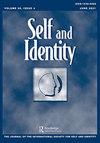A Network Approach to Understanding Narcissistic Grandiosity via the Narcissistic Admiration and Rivalry Questionnaire and the Narcissistic Personality Inventory
IF 2.1
4区 心理学
Q3 PSYCHOLOGY, SOCIAL
引用次数: 8
Abstract
ABSTRACT The narcissistic admiration and rivalry concept (NARC) model of grandiose narcissism posits that striving for uniqueness, grandiose fantasies, and charmingness define narcissistic admiration, whereas striving for supremacy, devaluation, and aggressiveness define narcissistic rivalry. Given these complex interrelationships, we explored the structure of grandiose narcissism using the Narcissistic Admiration and Rivalry Questionnaire (NARQ) and Narcissistic Personality Inventory (NPI) via network analysis in four separate samples which allowed us to assess the extent to which these networks replicated across these samples (total N = 3,868). Overall, grandiose cognitions from the NARQ emerged as a highly central node in each network, providing compound evidence for its replicability and generalizability as an important feature of grandiose narcissism within the NARC model. Charmingness from the NARQ emerged as a central node throughout Samples 1, 2, and 3, with strong connections to features of narcissistic admiration and narcissistic rivalry (e.g., grandiose fantasies and aggressiveness), but was less central in Sample 4. To our knowledge, this is the first research to examine the replicability of the network structure of grandiose narcissism across various samples. These findings add to an increasingly important dialogue regarding replicability in psychological network science.自恋崇拜与竞争问卷和自恋人格量表的网络化方法
摘要:宏大自恋的自恋崇拜与竞争概念模型认为,追求独特性、宏大幻想和魅力定义了自恋崇拜,而追求霸权、贬低和攻击性定义了自恋竞争。鉴于这些复杂的相互关系,我们使用自恋崇拜和竞争问卷(NARQ)和自恋人格问卷(NPI),通过对四个独立样本的网络分析,探索了自恋的结构,这使我们能够评估这些网络在这些样本中的复制程度(总N=3868)。总的来说,来自NARC的宏大认知成为每个网络中的一个高度中心节点,为其可复制性和可推广性提供了复合证据,这是NARC模型中宏大自恋的一个重要特征。NARQ的魅力在样本1、2和3中都是一个中心节点,与自恋崇拜和自恋竞争的特征(例如,浮夸的幻想和攻击性)有着密切的联系,但在样本4中则不那么重要。据我们所知,这是第一项在各种样本中检验宏大自恋网络结构可复制性的研究。这些发现为心理网络科学中关于可复制性的日益重要的对话增添了内容。
本文章由计算机程序翻译,如有差异,请以英文原文为准。
求助全文
约1分钟内获得全文
求助全文
来源期刊

Self and Identity
PSYCHOLOGY, SOCIAL-
CiteScore
5.10
自引率
5.00%
发文量
26
期刊介绍:
Work on self and identity has a special place in the study of human nature, as self-concerns are arguably at the center of individuals" striving for well-being and for making sense of one"s life. Life goals develop and are influenced by one"s view of what one is like, the way one would ideally like to be (or would like to avoid being), as well as one"s perceptions of what is feasible. Furthermore, conceptions of self and the world affect how one"s progress towards these goals is monitored, evaluated, redirected, re-evaluated, and pursued again. Thus, the “self” as a construct has far-reaching implications for behavior, self-esteem, motivation, experience of emotions and the world more broadly, and hence for interpersonal relationships, society, and culture.
 求助内容:
求助内容: 应助结果提醒方式:
应助结果提醒方式:


